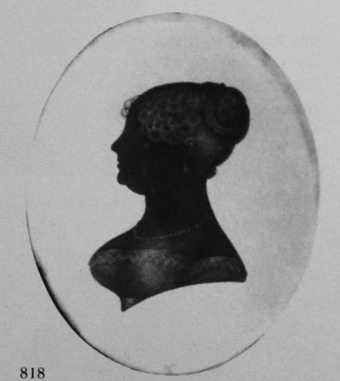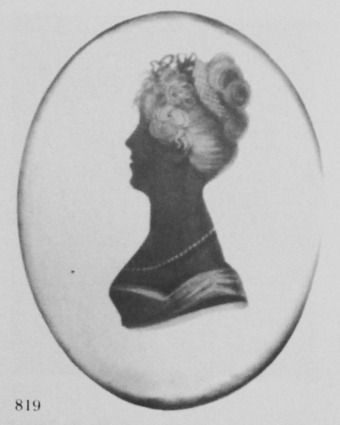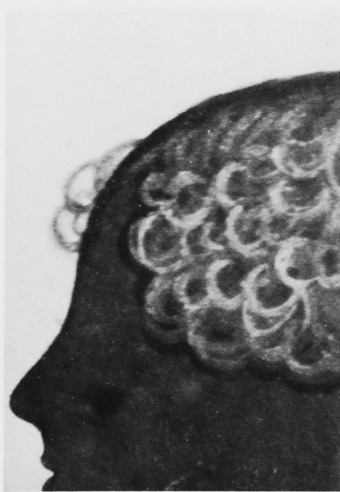Hallam, John (McKechnie Section 2)
See also Section One
Recorded by Jackson (Dictionary). (Foskett lists only one miniaturist with this name, a Miss Hallam, who worked during the early 1800s and cannot have been the same artist.) Since examples of Hallam's work have been recorded in places as far apart as Edinburgh, Torquay, and Bridgnorth, he was obviously an itinerant artist, whose origins may never be traced. Some silhouettes have been seen in papier mâché frames with brass hangers engraved with the words 'Edinh/ Museum'. One of these was dated 1819. Mr J. W. Cockburn, City Librarian in Edinburgh, told me that Stark's Picture of Edinburgh, 1819 mentions a University Museum, founded by Sir Andrew Balfour, which contained 'a series of medals, pictures, and busts, the remarkable arms, clothing and ornaments of foreign countries, mathematical philosophical and surgical Instruments, &c.'. The coincidence of date suggests that Hallam managed a sideshow at this museum where he painted and sold silhouettes, but there is no record of this artist in the Edinburgh street directories, burgess rolls, or burial records. Hallam was still in practice in 1821: a handbill, printed for use in Bridgnorth and dated 26 December 1821, has recently come to light. This mentions no royal portraits, and since we know that Hallam, on some frames, incorporated a hanger showing the royal crown and his own name, we can conclude that any silhouettes of royal sitters were taken after 1821. We do not know, however, which member or members of the Royal Family sat to Hallam. The text of the Bridgnorth handbill (a copy is in the John Johnson collection, Bodleian Library) is as follows:
MODERN STYLE OF EXECUTING
likenesses.
MR. HALLAM, respectfully informs the Inhabitants of BRIDGNORTH and its Vicinity, that he executes Striking and Animated LIKENESSES in
TWO MINUTES' SITTING,
which are admired and approved of by the principal Artists and Amateurs in the Kingdom.
A variety of Specimens, (among which, are the Likenesses of several public Characters) may be seen of Mr. H. from two till four o'clock, at Mr. CURETON'S, Sen. Back Castle.
Ladies and Gentlemen (if required) waited on at their own Houses in Town or Country.
N.B. No Likeness to be kept unless approved of. Likenesses of ail descriptions accurately copied.
Mr. HALLAM respectfully solicits the early attention of those Ladies and Gentlemen who may please to honor him with their commands.
DECEMBER 26, 1821
Gitton's Typ.
Two examples of Hallam's work were sold by Sotheby and Company, London, on 16 and 26 March 1962.
Hallam painted finely in gold paint against a dark sepia base, apparently of body colour. Only profiles of women have been seen, and on these the shape of the figure above the neckline of the dress is carefully shown by fine strokes of gold. Hair is painted with a slightly coarser brush, but the curls, and the braided plaits worn about the knot near the top of the head, are all shown in full detail. So is the short necklace, often said to have been a special feature of Hallam's work, added by him as a finishing touch, though it should be remembered that he was working at a time when such necklaces were in fashion. The shapes of ear-rings are also well shown, as are details of dress.
Gum arabic is used beneath the line of the hair against the face, presumably to cake the hair stand out well from the face, but is not much used on other parts of a profile.
The bust-line finish varies in that a 'shadow line' is added in some cases.
Hallam's work is most like that of W. Mason and Jeffreson (qq..v.). Mason's gold paint, however, is much yellower, and Jeffreson's painting of hair is finer, without the line of gum arabic against the face which is a feature of Hallam's style.
Woodiwiss (British Silhouettes) records one printed trade label, as follows:
I. HALLAM
GOLD BRONZE TINT PROFILIST
To the Principal Nobility of the Kingdom.
There are other identifying features. Hallam sometimes signed his work in the shadow line (when he added this) below the bust-line. In Edinburgh (c. 1819) he used a brass hanger engraved with the words 'Edinh/ Museum', as I have mentioned. His silhouettes are sometimes seen in papier mâché frames, with the name 'I. Hallam', above a royal crown, shown on the brass hanger, with a laurel wreath below.
Ills. 818, 819, 983

Unknown woman
Silhouette painted on card, in gold and gum arabic against a sepia base colour
? c. 1822
3 2/8 x 2¾in./86 x 70mm.
Frame: papier mâché, with brass hanger showing the artist’s name and the Royal crown.
Author’s collection

Unknown woman
Silhouette painted on card, in gold and gum arabic against a sepia base colour
? c. 1823
3½ x 2½in./90 x 64mm.
Frame: papier mâché, with brass hanger showing the artist’s name and the Royal Crown.
From the collection of the late J. C: Woodiwiss

Front curls of a woman’s hair. Detail from a silhouette by I. Hallam. Note the outlining in gum arabic. (818)
